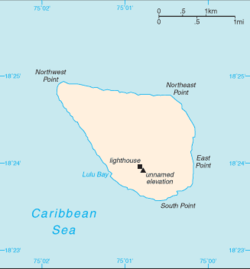Navassa Island is an uninhabited island in the Caribbean that is administered by the Fish and Wildlife Service of the Department of the Interior of the United States of America as a National Wildlife Refuge. The island is also claimed by Haiti. It lies about one-quarter of the way from Haiti to Jamaica.
Understand
[edit]
This island 160 km south of the U.S. Naval Base at Guantanamo Bay, Cuba has a land area of 5.2 km², most of which is exposed coral and limestone rock. It is flat to undulating with an unnamed raised plateau on the southwest side. At 77 metres (84 yd) high this is the highest point. It is ringed by vertical white cliffs that are typically 9 to 15 metres (9.8 to 16.4 yd) high and has a 8-kilometre (5.0 mi) coastline. The island has marine, tropical climate and has enough grassland to support goat herds as well as dense stands of fig-like trees and scattered cactus.
History
[edit]This uninhabited island was claimed by the U.S. in 1857 for its guano, and mining took place between 1865 and 1898. In the 19th and early 20th century guano (a product originating from bird feces on limestone that is used as fertilizer and a basis for explosives) was so important that the U.S. passed the Guano Islands Act allowing any U.S. citizen to claim any island not previously claimed by another nation for the U.S. if guano deposits were to be found there. Navassa Island is just one of many islands and islets that entered U.S. possession due to this curious piece of legislation, which is still in force. A 46-metre (50 yd) tall lighthouse was built in 1917, on the southern side of the island. The Coast Guard ceased operations and maintenance of Navassa Island Light in September 1996. After the lighthouse was shut down administration of Navassa Island transferred from the Coast Guard to the Department of the Interior. A 1998 scientific expedition to the island described it as a unique preserve of Caribbean biodiversity; the following year it became a National Wildlife Refuge.
The island is considered an unincorporated territory of the U.S. that is administered from Washington, DC, by the U.S. Fish and Wildlife Service, U.S. Department of the Interior. There has also been a private claim advanced against the island.
Landscape
[edit]Flora and fauna
[edit]Climate
[edit]Get in
[edit]Access to Navassa is hazardous. There is no airstrip or harbor on the island: an offshore anchorage is the only option. The island rises abruptly from the sea with cliffs reaching heights of 20 meters, further complicating matters. The island is not served by any marine services, though irregular research trips may visit the island. Your only option would be your own boat. As the island is U.S. territory, United States visa policy would theoretically apply, but in reality couldn't be enforced.
Fees and permits
[edit]Navassa Island is closed to the public. Visitors need permission from the Fish and Wildlife Office before entering the territory, which is unlikely to be granted except in extraordinary circumstances. U.S. citizens struggling to obtain permission can seek help from their elected representatives.
Get around
[edit]As there is no human settlement or infrastructure of any kind, you are probably best advised to walk.
See
[edit]Do
[edit]Buy
[edit]There is no economic activity on Navassa Island.
Sleep
[edit]Although the island is uninhabited, transient Haitian fishermen and others have been known to camp on the island.
Stay safe
[edit]The laws of the U.S. apply, although whether they can be and are enforced depends on the people that are on the island during your visit.
Stay healthy
[edit]There is no water on the island, be sure to bring enough with you. Due the extreme remoteness of the island, medical evacuation is likely to be impossible, so travel there only if you are in good health.
Go next
[edit]- Haiti, if you want civilization and human activity
